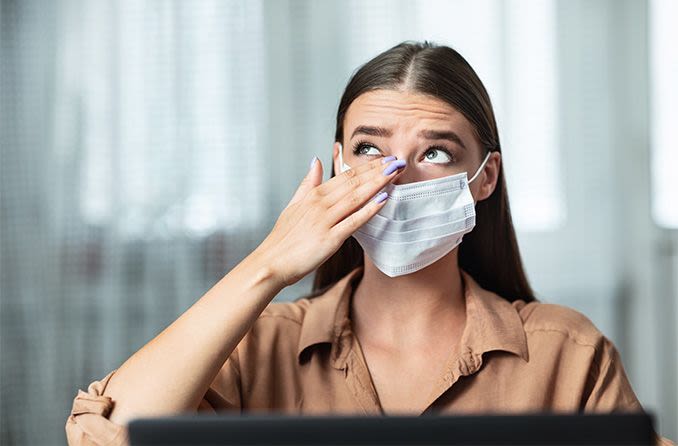Eye germs and viruses: Keeping hands, glasses and contacts clean

Coronavirus has made people hyper-aware of personal hygiene, especially when it comes to their hands and faces. Health officials and professionals across the globe are advising people to avoid touching their faces to avoid virus transmission through the eyes, nose and mouth.
Another way to reduce your risk of exposure to COVID-19 is to regularly sanitize your glasses and be diligent about the care of your contact lenses.
The COVID-19 crisis will pass in time, but making a few small changes to avoid eye germs and viruses can also help you avoid the seasonal flu and common colds.
Healthy habits to avoid eye viruses and bacteria
Adopt these healthy habits to keep your eyes — and the rest of you — healthy now and in the future:
DON'T TOUCH YOUR FACE: The easiest way you can keep germs out of your eyes is to avoid touching your face. This can transfer bacteria from your hands to your face, potentially causing an infection if they get into your eyes, nose or mouth.
GLASSES OR CONTACTS? If you wear contact lenses, the American Academy of Ophthalmology suggests switching to glasses to cut your infection risk. The American Optometric Association (AOA) and the Centers for Disease Control and Prevention (CDC) say wearing contacts is safe as long as the wearer is diligent about their care.
KEEP YOUR DISTANCE: Social distancing can be one of your greatest allies in the fight against germs. Keeping 6 feet away from other people in public, especially those who seem sick, gives you enough space to avoid respiratory droplets. Breathing in droplets from an infected person’s cough or sneeze can result in your own infection.
WASH YOUR HANDS: Hand-washing is an essential part of good hygiene and avoiding infectious diseases. It’s a very important step in preventing the spread of coronavirus and other infections. The CDC's hand-washing recommendations include lathering up and rubbing your hands together for at least 20 seconds before rinsing.
Diligently following these hygiene tips can go a long way toward preventing the transfer of viruses, bacteria and other germs to your eyes that can cause conjunctivitis or other eye infections.
SEE RELATED: What to do if you get hand sanitizer in your eye
How to sanitize your glasses
You can take all kinds of precautions to keep your hands clean, but it won’t do much good if your glasses are contaminated with germs. Viruses and bacteria can jump onto a clean hand if it comes in contact with a contaminated surface.
We asked Dr. Ryan Parker, Essilor's eye doctor spokesman, how to safely sanitize your glasses to cut your COVID-19 risk. "The best way to do this is no different than cleaning our hands," Parker says. "Using hot water and lotion-free soap will do the trick."
Don't use disinfectant wipes — if or when you can find them — to clean your glasses. They may ruin your lenses.
"You want to stay away from household glass cleaners as they have chemicals in them that can damage certain lens coatings," Parker says. "Also, you would want to stay away from soaps that have those abrasive beads in them," Parker says. "Simple soap and hot water will clean the lenses, remove bacteria and viruses, and be safe for all parts of the glasses."
Another option: "A diluted solution (70%) of isopropyl alcohol is also useful," Parker says. "It should not pose any issues to good-quality lenses, but one should be careful because it can remove some ink and dyes from the frame."
After washing your glasses, dry them with a soft cloth. Avoid paper products like paper towels and facial tissues, Parker says.
Finally, how often should you sanitize your glasses? Once a day, Parker says.
SEE RELATED: How to clean your glasses the right way
How to clean reusable contact lenses
When cleaning your reusable contact lenses, the first step is to wash your hands, drying them with a clean, lint-free towel.
Next, place one lens in the palm of your hand and rinse it with contact solution. While still in your palm, gently rub the lens with your finger tip to ensure any debris and allergens are removed. Then give the lens one more quick rinse.
After ensuring your contact case is clean (clean your case following the same steps as cleaning your glasses), place the lens into the container. There should be no old solution remaining inside the case; this can lead to contamination and possibly infection.
Finally, fill the compartment with fresh contact solution directly from the bottle. Repeat the process for the other contact lens, and you’re all set.
Taking care now with your contacts, your glasses and most importantly your eyes will help keep you healthy in these challenging times.
STUCK AT HOME BUT NEED NEW GLASSES OR CONTACTS? Shop for eyewear at an optical store near you (more stores are opening back up) or an online retailer.
Page published on Sunday, April 12, 2020




